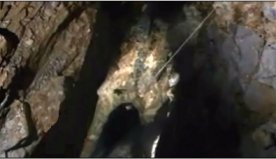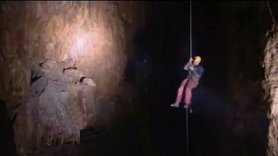
November Editorial

November Editorial
Titan - Britain's largest cave |
|
How can something almost twice the size of St Paul's cathedral be lost for almost a century? Because it's underground. In fact Titan had hit the headlines for what is not there. It's an underground hole about 140 metres from floor to ceiling. This makes Titan almost 60m taller than Gaping Gyhll in Yorkshire Dales, which was the previous record holder. Titan is near Castleton which lies at the northern rim of the Peak District limestone area and is the home to four of Derbyshire caves: the Peak Cavern, Speedwell Cavern, Treak Cliff Cavern and Blue John Cavern (the latter is the place from where Blue John stone comes from - a colourful felspar used to make goblets and other decorative stone artifacts. Apart from Blue john another 13 varieties of Felspar are to be found in this cave.) Treak cliff, on the other hand has numberous stalagtites and interesting mineral deposits.) The Peak-Speedwell System is Derbyshire's longest cave. It stretches from the the main entrance of Peak Cavern (The Vestibule) to the Far Sump - a distance of over 17 km. (A sump is a place where water completely fills the cave passage.) The Peak-Speedwell System also has the UK's biggest natural shaft and the second deepest sump. A subterranean river called River Styx (naturally) flows through Peak Cavern making some of the passages very difficult, as in the case of Far Sump. At the end of Far Sump is an extension leading to Titan. 
Although Titan was discovered on the 1st of January 1999, it was known since 1981 that there was something beyond the Far Sump extension. After 1981 various divers investigated the site but it soon become apparent that digging to Titan from the Far Sump was not going to be possible. What was needed was an opening from the dry land, if one could be found. The breakthrough came - and from a university library instead of geological exploration. Dave Nixon, a local potholer and a leading underground explorer, found an article written in 1793 by James Plumtree, a Cambridge student, who had been exploring old mines in the area. He described a network of caves stretching beyond the well-known Peak-Speedwell system. It became apparent that the original entranceto the cave system which was described in the journal must have been blocked by a rockfall. Nixon and his group took another three years to dig through and discover the long cave system which lead the group to Titan. The original underground journey was a challenging 5 hour obstacle course. But now Nixon and his team have completed a man-made shaft which allows explorers to abseil down into the cave. The top entrance is in a very unlikely place, perched almost on top of Hurdlow, one of the highest hills above Castleton. Prior to work on the dig only a tiny shakehole hinted at the existence of a cave below. Titan is still an active digging site and for reasons of safety, there is no general access. However, recently A BBC team led by Inside Out presenter Morland Sanders and producer Mike Jackson abseiled into Titan with specialist cameraman Rob Franklin. As Morland Sanders commented: "It was in many ways a terrifying experience but the size of the cave is truly awesome." The cave was carved out over millions of years by water eroding the local limestone, and contains a massive waterfall which plunges deep below ground level. There is a good description of the original underground route leading to Titan in the "Caves of Castleton" article. And you can also see a short film from the descent into the Titan of the BBC team here Mr Nixon and his team are still exploring hoping that their next discovery is just round the corner. |
| _______________________________ | ||||
| Home | | | Shopping | | | Database |
© Biscuit Software 2004-2015
All rights reserved